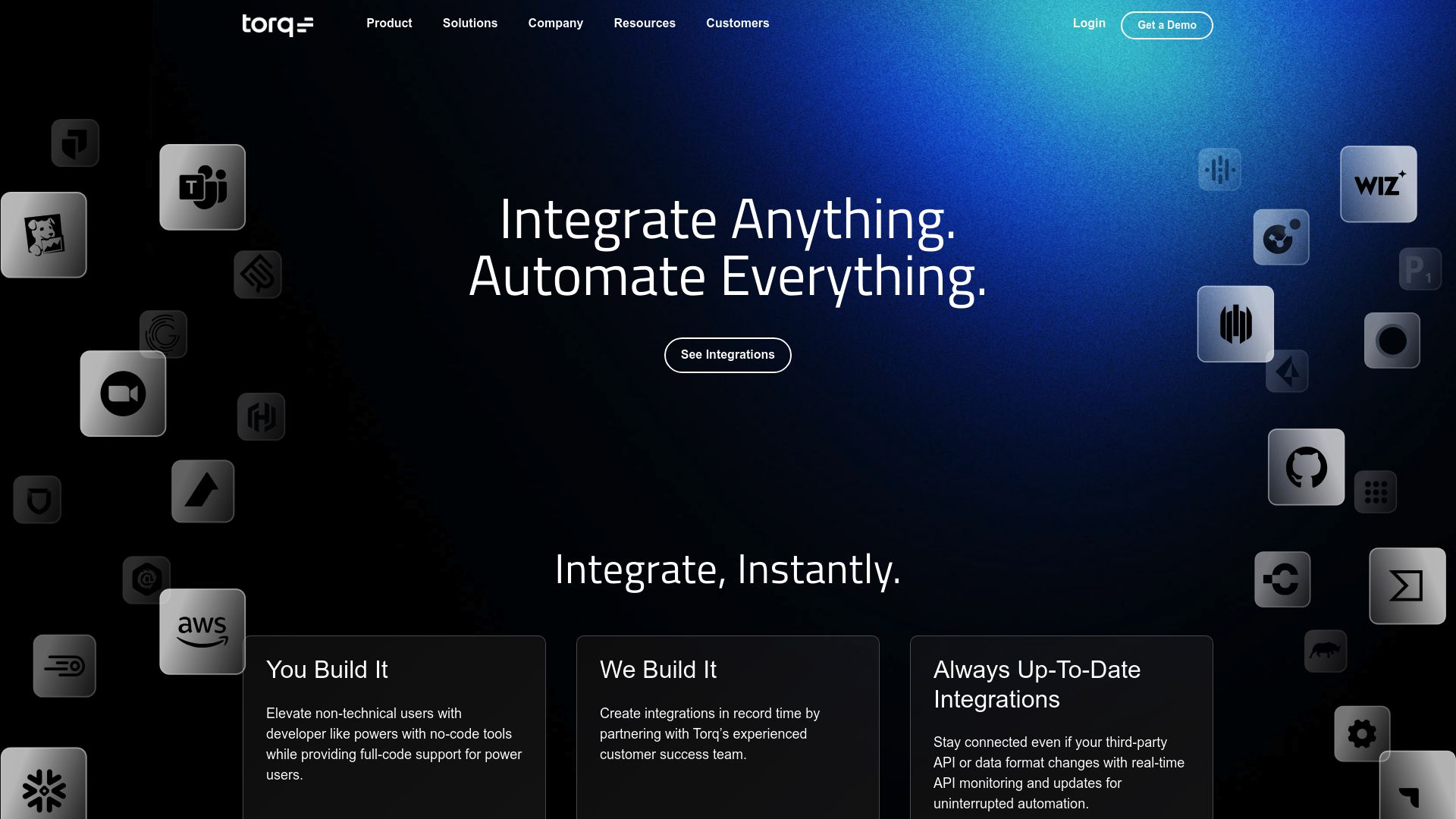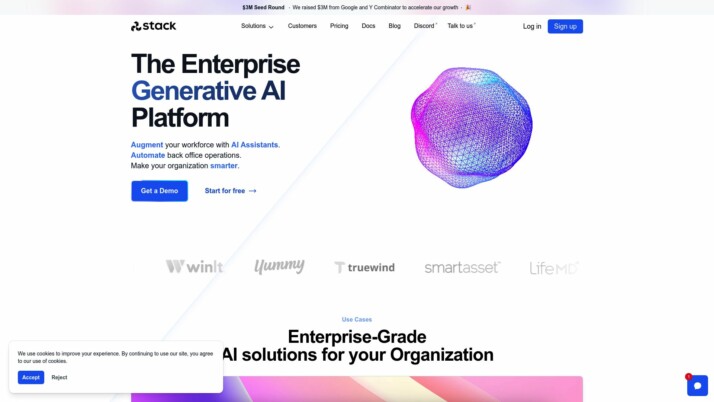Torq Hyperautomation vs. Stack AI: Comparing AI-Powered Automation Platforms
AI-powered automation platforms are reshaping how businesses operate, from enhancing security protocols to streamlining complex workflows. This review compares Torq Hyperautomation vs. Stack AI, and SmythOS, three innovative solutions at the forefront of this technological revolution. We examine their unique approaches to AI integration, workflow automation, and user accessibility, highlighting how each platform addresses the evolving needs of modern enterprises. Whether you’re a seasoned developer, a business leader, or an AI enthusiast, this comparison offers valuable insights into choosing the right tool to elevate your organization’s capabilities in an increasingly AI-driven world.
Torq Hyperautomation Overview
Torq Hyperautomation offers an AI-driven platform for enterprise-grade security operations. The software connects diverse security tools, enabling organizations to automate complex processes and respond rapidly to security events. Torq’s no-code visual workflow designer empowers security teams to create sophisticated automation without extensive programming knowledge.
The platform excels in orchestrating security tasks across an organization’s tech stack. Its robust integration capabilities allow seamless connections with numerous third-party services, enhancing the scope and effectiveness of security automation. Torq’s workflow engine supports a wide range of triggers, from API calls to scheduled events, ensuring comprehensive coverage of security scenarios.
Torq’s no-code visual workflow designer empowers security teams to create sophisticated automation without extensive programming knowledge.


Torq’s strength lies in its ability to handle complex security processes at scale. The platform’s case management feature automates the entire lifecycle of security events, from initial detection to resolution. This capability significantly reduces response times and minimizes the risk of human error in critical security operations.
Torq’s strength lies in its ability to handle complex security processes at scale.
While Torq Hyperautomation provides powerful security automation, it lacks specific AI agent capabilities. The platform focuses on workflow automation rather than deploying autonomous AI agents. This limitation may affect organizations looking for more advanced AI-driven security solutions. Additionally, the platform’s specialization in security automation may restrict its applicability in non-security related automation tasks.
Torq’s workspace feature facilitates collaboration among security teams, allowing for efficient resource sharing and role-based access control. This collaborative environment, combined with detailed execution logs, enhances transparency and accountability in security operations. However, users should be aware that mastering the platform’s full potential may require a learning curve, especially for those new to security automation concepts.
Stack AI Overview
Stack AI empowers users to create AI-powered workflows and custom AI assistants without extensive coding expertise. The platform’s low-code approach democratizes access to advanced AI capabilities, enabling businesses to leverage intelligent automation across various industries.
Stack AI’s visual builder offers a user-friendly drag-and-drop interface, making it accessible to both technical and non-technical users. The platform supports customizable deployments, allowing users to integrate AI solutions seamlessly into existing workflows. With pre-built templates for common use cases, Stack AI accelerates the development process while maintaining flexibility for specific needs.


Stack AI’s visual builder offers a user-friendly drag-and-drop interface, making it accessible to both technical and non-technical users.
Security stands out as a key strength of Stack AI. The platform boasts enterprise-grade security measures, ensuring compliance with SOC 2, HIPAA, and GDPR standards. This focus on data protection and privacy makes Stack AI suitable for organizations handling sensitive information across various sectors.
Stack AI excels in its integration capabilities, supporting connections with popular services like Google Drive, Salesforce, Airtable, and Slack. This extensive ecosystem enables users to incorporate AI-driven processes into their existing tech stacks, enhancing overall productivity and efficiency.
While Stack AI offers powerful features for building AI assistants and automating workflows, it may have limitations in areas such as autonomous agent capabilities and advanced AI research tools. Users seeking highly specialized AI functionalities or extensive customization options might find the platform’s offerings somewhat constrained compared to more developer-centric alternatives.
Feature Comparison
Torq Hyperautomation and Stack AI offer distinct approaches to workflow automation and AI integration. Torq focuses on security operations, providing a robust platform for automating complex security processes. Stack AI, on the other hand, emphasizes low-code AI development for a broader range of business applications.
Torq Hyperautomation excels in security-focused features, offering detailed execution logs, role-based access control, and extensive API integrations tailored for security operations. Its workflow engine supports various triggers and provides case management capabilities for handling security events. However, Torq lacks specific AI agent capabilities and may have limited applicability outside security automation.
Stack AI differentiates itself with its emphasis on AI-powered workflows and custom AI assistants. It provides a user-friendly drag-and-drop interface and supports customizable deployments, making it accessible to both technical and non-technical users. Stack AI’s strengths lie in its integration capabilities with popular services and its focus on enterprise-grade security compliance. Yet, it may have limitations in areas such as autonomous agent capabilities and advanced AI research tools compared to more specialized platforms.
While both platforms offer visual builders and no-code options, they diverge in their core focus. Torq Hyperautomation’s security-centric approach contrasts with Stack AI’s broader AI application development. This fundamental difference impacts their feature sets, with Torq offering more specialized security automation tools and Stack AI providing a more versatile platform for general AI-driven workflows.
Feature Comparison Table
| Torq Hyperautomation | Stack AI | SmythOS | |
|---|---|---|---|
| CORE FEATURES | |||
| Explainability & Transparency | ❌ | ✅ | ✅ |
| Problem-Solving Capabilities | ❌ | ✅ | ✅ |
| Human-AI Interaction | ❌ | ✅ | ✅ |
| SECURITY | |||
| Constrained Alignment | ✅ | ❌ | ✅ |
| IP Control | ✅ | ❌ | ✅ |
| COMPONENTS | |||
| Huggingface AIs | ❌ | ❌ | ✅ |
| Zapier APIs | ❌ | ✅ | ✅ |
| All other APIs, RPA | ❌ | ✅ | ✅ |
| Logic | ❌ | ✅ | ✅ |
| DEPLOYMENT OPTIONS (EMBODIMENTS) | |||
| Deploy as API | ❌ | ✅ | ✅ |
| Production Domains | ❌ | ✅ | ✅ |
| API Authentication (OAuth + Key) | ❌ | ✅ | ✅ |
| Deploy as Scheduled Agent | ❌ | ❌ | ✅ |
| Scalability | ❌ | ✅ | ✅ |
| DATA LAKE SUPPORT | |||
| Sitemap Crawler | ❌ | ❌ | ✅ |
| YouTube Transcript Crawler | ❌ | ❌ | ✅ |
| URL Crawler | ❌ | ✅ | ✅ |
| PDF Support | ❌ | ✅ | ✅ |
Best Alternative to Torq Hyperautomation and Stack AI
SmythOS stands out as the superior alternative to Torq Hyperautomation and Stack AI, offering a comprehensive platform for AI agent development and deployment. We provide a versatile solution that combines ease of use with powerful capabilities, making advanced AI accessible to users across skill levels.
Our drag-and-drop interface simplifies the creation of complex AI workflows, eliminating the need for extensive coding knowledge. This visual approach democratizes AI development, allowing both technical and non-technical users to build sophisticated agents quickly. Unlike Torq’s security-centric focus or Stack AI’s general low-code approach, SmythOS delivers a balanced platform that excels in various domains.
SmythOS delivers a balanced platform that excels in various domains.
SmythOS’s extensive integration ecosystem sets it apart from competitors. We support a wide array of APIs, AI models, and tools, including popular services like Slack, GitHub, and Stripe. This flexibility ensures seamless integration into existing workflows and business processes. While Stack AI offers some integrations, SmythOS provides a more comprehensive set of connectors and pre-built templates, significantly reducing setup time and accelerating innovation.
One of our key advantages is the support for multi-agent orchestration. SmythOS enables the creation of collaborative AI systems, where multiple agents work together on complex tasks. This feature enhances efficiency and scalability, surpassing the capabilities of both Torq Hyperautomation and Stack AI. Our platform also excels in deployment options, allowing users to integrate AI solutions across various platforms, including major cloud services and even as ChatGPT plugins or Alexa skills.
SmythOS enables the creation of collaborative AI systems, where multiple agents work together on complex tasks.
We prioritize scalability and performance, ensuring that our platform can handle enterprise-level demands while maintaining flexibility for smaller projects. Our commitment to security and compliance matches industry standards, addressing concerns that are crucial for both Torq Hyperautomation and Stack AI users. With SmythOS, users gain a powerful, versatile, and user-friendly platform that combines the best aspects of automation and AI development, making it the ideal choice for businesses and developers looking to harness the full potential of AI technology.
Conclusion
Torq Hyperautomation and Stack AI offer powerful solutions for security automation and AI-driven workflows, respectively. Torq excels in orchestrating complex security processes, while Stack AI provides a versatile platform for creating AI assistants across industries. However, SmythOS emerges as the superior choice, combining the strengths of both platforms and offering unparalleled versatility.
SmythOS’s drag-and-drop interface surpasses Stack AI’s low-code approach, making AI development accessible to users of all skill levels. Unlike Torq’s security-focused platform, SmythOS supports a wide range of applications beyond cybersecurity, including marketing, sales, and customer support. Our platform’s extensive integration ecosystem, featuring over 300,000 pre-built connectors, outshines both competitors in terms of flexibility and scope.
While Torq and Stack AI offer valuable features, SmythOS provides a more comprehensive solution for businesses seeking to leverage AI across their operations. Our multi-agent orchestration capabilities, versatile deployment options, and support for various AI models from providers like OpenAI and Anthropic set us apart. SmythOS empowers users to create once and deploy anywhere, streamlining the development and implementation of AI solutions.
To experience the future of AI automation and unlock your business’s full potential, we invite you to explore our diverse range of AI-powered agent templates or create a free SmythOS account. With our 30-day money-back guarantee and unlimited agent creation, you can start building and deploying AI agents risk-free today. Discover how SmythOS can revolutionize your workflow and drive innovation across your organization.
Last updated:
Disclaimer: The information presented in this article is for general informational purposes only and is provided as is. While we strive to keep the content up-to-date and accurate, we make no representations or warranties of any kind, express or implied, about the completeness, accuracy, reliability, suitability, or availability of the information contained in this article.
Any reliance you place on such information is strictly at your own risk. We reserve the right to make additions, deletions, or modifications to the contents of this article at any time without prior notice.
In no event will we be liable for any loss or damage including without limitation, indirect or consequential loss or damage, or any loss or damage whatsoever arising from loss of data, profits, or any other loss not specified herein arising out of, or in connection with, the use of this article.
Despite our best efforts, this article may contain oversights, errors, or omissions. If you notice any inaccuracies or have concerns about the content, please report them through our content feedback form. Your input helps us maintain the quality and reliability of our information.
